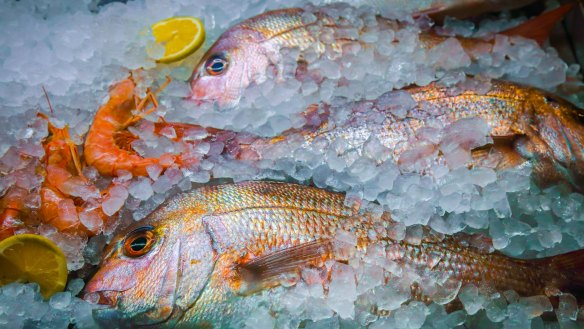Is frozen fish really better than fresh fish?

I heard a TV chef saying on their cooking show that frozen fish is better than fresh fish. How can that be? L. Morgan
Are you sure you weren't watching an ad? Hard to tell sometimes. By the time a fish served in a restaurant is caught at sea, stored just above freezing, transported to the port, transported to the market, sold, transported to the restaurant or retailer, cooked and taken to your table, half a week may have passed. Freezing fish causes ice crystals to form in the flesh, which breaks down the cell walls. If you slowly freeze a fish, great big ice crystals will form and will cause a lot more damage than if you were to freeze it really quickly. Some fishing boats have processing facilities on board in which fish are cleaned and filleted, wrapped in freeze-proof plastic, and blast-frozen at minus 40C. When appropriately thawed, this will have the same eating quality as fresh fish that has been kept on ice for two days. This was proved by researchers in Queensland who put samples of raw fresh and frozen fish in front of a panel of top chefs. Apart from a sheen on the fresh fish, the chefs were unable to tell the difference between selected species of fresh and frozen. Fresh fish, straight from the sea, has a fresh zing that cannot be replicated while some fish, as Sydney chef Josh Niland has taught us, improve with a little dry ageing. If you are thawing seafood, keep it in original packaging and thaw in a container, in the fridge below 4C within 12 hours. Use within 48 hours.
Is it polite to run one's finger around a plate to get the last of the sauce/juices/gravy? P.G. O'Leary
I was at lunch recently with a friend. We were at Tansy Good's eponymous restaurant in the central Victorian town of Kyneton. The saffron-infused sauce on the fish dish was so delicious, I had to finish it off. My friend held up her scarf to hide me from the rest of the diners, and I lifted the plate to my face and licked it clean. I am a big bald man and it would have been scary for the table of lunching matrons opposite. Instead, I could have asked for more bread. Bread is the mop on the dinner table for sopping up the juices. One tears a little piece of bread, holds it between the thumb and index and forefingers, and pushes the bread forward to soak up the juices. This is particularly true of dining culture in France, Spain and Italy. In Italy, the bread used to soak up the sauce on a plate, is known as la scarpetta or "the little shoe". Hence the expression fare la scarpetta (make the little shoe). In the north of England, the process of cleaning up the gravy on a dinner plate from a roast dinner with Yorkshire pudding is called "mopping up". Either is preferable to running a finger on the edge of the plate.
Send your vexing culinary conundrums to brainfood@richardcornish.com.au or tweet to @realbrainfood.
Appears in these collections
- More:
- Food
- Brain food
